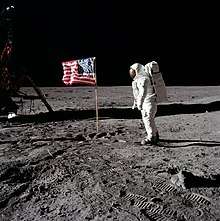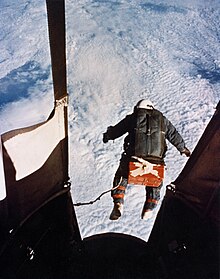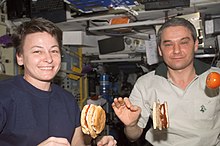 | WARNING: Due to the outbreak of the infectious disease COVID-19 (see coronavirus pandemic), caused by the virus SARS-CoV-2, also known as coronavirus, there are travel restrictions worldwide. It is therefore of great importance to follow the advice of the official bodies of Belgium and Netherlands to be consulted frequently. These travel restrictions may include travel restrictions, closure of hotels and restaurants, quarantine measures, being allowed to be on the street for no reason and more, and can be implemented with immediate effect. Of course, in your own interest and that of others, you must immediately and strictly follow government instructions. |
Commercial space travel is limited to few people right now, but it is possible – for those who can afford it.
Potential Destinations
Possible Visitable Destinations

There are three visitable alien destinations.
| International Space Station A space station orbiting the Earth. |
| Moon The moon orbits the Earth and was first visited in 1969. At the time, American astronauts took three days to get there. |
| Mars This planet has the most similarities with Earth. However, it is much further away than Earth and therefore it is often very cold. There have never been manned space flights to Mars, but there have been unmanned spaceships and they take a year to get there. |

Other destinations
- Mercury — The planet closest to the sun.
- Venus — This planet is usually seen as a bright "star" from Earth in the morning and evening.
- Jupiter — The largest planet in the solar system, it is best known for its great red spot.
- Saturn — This planet is best known for its rings of ice and dust particles.
- Uranus — The only planet in our solar system that lies on its side.
- Neptune — The farthest planet from the sun, making it always cold.
Info
Traveling in space offers the opportunity to get a better look at the moon, stars, planets and other celestial bodies. Astronomers can do a lot of research on the Earth and its origin from space. For meteorology, there are satellites that take pictures from space. Other satellites are there for communication purposes.
Earth is just a small planet in a vast space that is about to be explored further. No one knows exactly how big the universe is or whether it actually has limits. But we do know that it extends far beyond what we can see with the telescopes. From the most distant objects we can see, light takes about 10 billion years to reach Earth (that's nearly 10 trillion kilometers per year). But are there any more planets like our Earth in that endlessly deep space? And is there life on it? A question that currently remains unanswered...
History
The space

It is a mystery how space came to be. According to astronomers, space was actually concentrated in one point and there were no planets, stars or other celestial bodies. Time wouldn't even have existed. Until 20 billion years ago. Space is believed to have been created by a large explosion called the Big Bang.
The celestial bodies created in that explosion are said to have been flung out from the center and made up of hydrogen. Only during nuclear fusion processes (that is, the fusion of the nuclei of different atoms, whereby another element is formed), all known elements were formed. From this, in turn, celestial bodies, such as stars and planets, arose.
Not so long ago, astronomers were able to measure some heat moving through the universe. This would be a bit of residual heat that would have been left over from the Big Bang. For some, this is proof that the Big Bang actually happened.
Our own solar system, of which the Earth is also a part, was not there from the beginning. Our sun would have formed about 5 billion ago, from a cloud of dust and gas. Not everything would have been used and from that the planets would have arisen.
Scientists are now studying gas and dust clouds that orbit other planets and have been able to prove more and more of the big bang theory. Nowadays, more and more planets are being discovered that orbit other stars, the so-called exoplanets. So it is not the case that only planets revolve around the sun. Exoplanets are too far away to see through a telescope, but data has been used to estimate the size, cross section of their orbit and orbital speed.
space travel

For the beginning of space travel we have to go back in time to 1865. In his science fiction novel De la terre a la lune Jules Verne described a trip to the moon. People would have been fired with a large cannon. However, this was not taken seriously at the time.
It would be more than a hundred years before the first moon journey took place. The Russian Konstantin Tsiolkovsky designed spacecraft and other systems to travel through space.
Finally, on October 4, 1957, it was also the Soviet Union that orbited the first satellite, Sputnik I. A month later, Sputnik II launched the first living creature, a dog named Laika, into space.
At that time, manned spaceflight was not long in coming. The first human was launched on April 12, 1961. The Russian Yuri Alekseyevich Gagarin orbited the Earth in the Vostok I, after which he landed safely.
Shortly after, the United States also went into space. They aimed to make a moon landing before 1970. On July 20, 1969, they succeeded. It was Neil Armstrong and Buzz Aldrin who stepped out of the Apollo 11 lunar lander to set foot on the moon. Armstrong spoke the legendary words: "That's one small step for a man, one giant leap for mankind".
After the Apollo era, there were really no boundaries to be discovered. Until recently at least. After construction of the International Space Station, which began in 1998 and lasted until 2011, space agencies are now gearing up to make the first manned journey to Mars.
Arrive

To get into space it is very important that you are physically fit, but the crucial point is how thick your wallet is. Getting yourself into space via non-commercial aviation is usually not for ordinary citizens.
The only realistic option to get into space is by spacecraft. There are several places in the world where spacecraft are launched, whether manned or not. An overview of the main launch sites with the most launches:
- Cosmodrome Baykonur in Kazakhstan
- Cape Canaveral Air Force Station in the United States
- Vandenberg Air Force Base in the United States
- capustin jar in Russia
- Cosmodrome Plesetsk in Russia
- Center Spatial Guyanais in French Guyana
- Kennedy Space Center in the United States
- Jiuquan Launch Base in China
Virgin Galactic and Space Expedition Corporation, two commercial companies that want to offer space flights for tourists, would make a space trip possible for as little as 75,000 euros. The planes could fly at an altitude of 100 kilometers, outside the atmosphere and high enough to see the curvature of the earth. The aim is to get into orbit around the earth, so that it can land anywhere in the world within an hour and a half. Tickets for future space travel are already being sold. But think carefully before paying because many space companies quickly go up in smoke or are declared bankrupt.
To look at

- Because there is no more atmosphere in space, the stars no longer seem to twinkle.
- Sunrises and sunsets, again due to the absence of an atmosphere, have much less color.

International Space Station

Moon in the atmosphere

Saturn

star nebula
To do

- freefall is a phenomenon that, while not unique to space travel, occurs only briefly on Earth, such as in amusement park rides and high-speed elevators.
- Scientific missions. Tourists traveling on scientific missions are expected to cooperate, at least in the medical field.
- Spacewalk. This involves leaving the spacecraft to float around in space. This requires a good fitness condition.
- space diving. Orbital Outfitters is designing the Sub-orbital Space Suit One. This suit is used by suborbital space flight crews and should be rated for a drop of 120,000 feet (over 36,500 meters).
Food

At the beginning of space travel, food was not much. In the early 1960s, meals consisted of bite-sized blocks, freeze-dried powders, and tubes of semi-liquids. However, the astronauts who participated in the Mercury program (1959-1963) did not find this food appetizing. They also had problems adding water to the freeze-dried food and did not like squeezing the tubes or cleaning up the crumbs. In the subsequent space programs (Gemini program and Apollo program), the menu was expanded to include products such as shrimp cocktails, chicken and vegetables, toast and apple juice, and the freeze-dried food could be stored in zip-lock containers. Moreover, due to the improved composition, it could also be eaten with a spoon.
Today, food for space travelers comes in more and more forms, but in 2021 its quality is still not comparable to that of an average restaurant. The food should not crumble or drip, as these crumbs and drops float through the spacecraft due to the weightlessness and can disrupt the equipment. That is why the food is specially packaged and the drink comes in a bottle with a straw.
stay overnight
- Bigelow Aerospace is a company that wants to run an astro-hotel for tourists in the long term. For this purpose, inflatable modules are used that can be unfolded in one day. The modules have already been tested on the ISS as an experiment. [1]
- ISS The space station is currently reserved for astronauts and cosmonauts.
Safety

Today's technology is safer than that of the 1960s, yet space remains a dangerous environment to be in. Cosmic rays, extreme temperatures, meteorites and space debris, technical problems, high speeds, explosive substances, the distance to solid ground and the absence of an atmosphere make any unforeseen situation potentially life-threatening.
As a space traveler, you have to be very careful about making space flight reservations for projects that have not yet started. If there are problems with the project or the company goes bankrupt, it could just happen that your trip is canceled and you also lose all your invested money.
Health
People going into space must be well trained and physically fit.
all around

| Destinations | ||||||||
|---|---|---|---|---|---|---|---|---|
|





